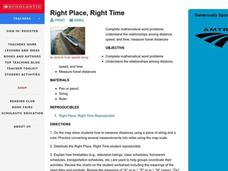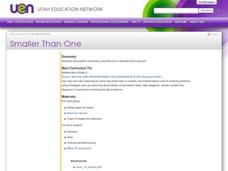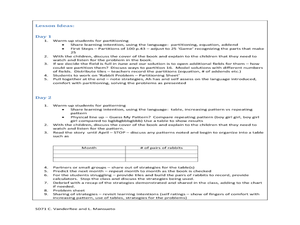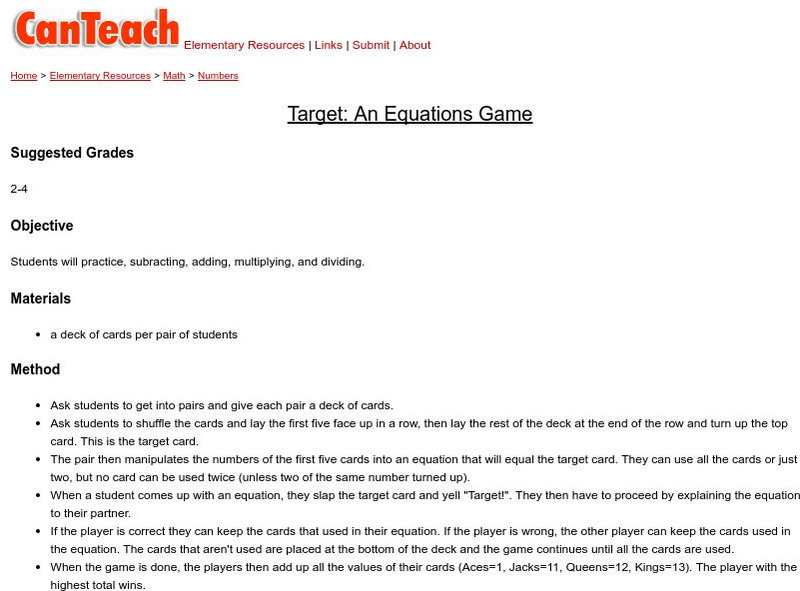Pennsylvania Department of Education
Shapes Around Us
Learners use manipulatives to study shapes. They sort shapes and use correct geometric terminology to describe them. Students find real-life examples of 2 and 3 dimensional shapes, and classify figures in their classroom according to...
Curated OER
Order of Operations
Fourth graders develop an understanding of the order of operations by relating to putting on a sock and shoe. In this order of operations lesson, 4th graders a mnemonic device to complete math examples. Students can communicate the...
Pennsylvania Department of Education
Use Order of Operations to Evaluate Expressions—No Grouping Symbols
Students identify and explain different types of data collection and graphs. In this graphs and data collection instructional activity, students record their observations of a variety of data collection tools and graphs displayed in the...
Curated OER
Right Place, Right Time
Fourth graders complete mathematical word problems. They study the relationships among distance, speed, and time; and measure travel distances. They measure distances using a piece of string and a ruler and practice converting several...
Curated OER
Smaller Than One
Sixth graders practice converting a fraction into a decimal and a percent. They explain relationships among rational numbers. They order and compare whole numbers, fractions (including mixed numbers), and decimals using a variety of...
Curated OER
Medieval Money
Learners investigate the history of money as it was back then compare to now. In this algebra lesson, students analyze the type of money used in medieval times, the value of the currency and the coins used. They make a budget using...
Curated OER
Calculating Total From Percents
Using this short review of finding a percentage of a number, learners can practice important skills. There are twelve questions on this activity.
Curated OER
Linking Length, Perimeter, Area, and Volume
Students explore measurements of rectangles. In this measurement comparison instructional activity, students discover the length, width, perimeter, and area of two different rectangles. Students record their measurements on a chart to...
Curated OER
The Rabbit Problem
Learners notice a number pattern in the book The Rabbit Problem by Emily Gravett. In this number pattern lesson, students represent and describe numbers appropriate to their grade level.
Curated OER
Playing With the Grid
Students examine works of grid art by the painter Chuck Close. They discuss the process of creating a drawing using a grid, view images of grid art, and create a grid drawing.
Helping with Math
Percentages: Calculating Percent - 2
Here is a worksheet on which math classes practice calculating the percentage of different numbers. Some of the percentages involve decimals, so this would not be an assignment for first-time percent calculators! You can print the...
Helping with Math
Ratio and Proportion: Simplifying Ratios (1 of 2)
Here is a set of 24 pairs of numbers for which kids reduce the ratios to their simplest form. It is a simple and straightforward assignment, meant by the publisher to address CCSS.Math.Content.6.RP.3. Note, however, that it only requires...
Curated OER
The Mandelbrot Set
Students are introduced to the notion of a complex number and function iteration in order to motivate the discussion of Julia sets and the Mandelbrot set.
Curated OER
Getting Familiar with Fractals
Students use the Internet to answer lab questions about fractals, and then construct fractals using the initial stage and iteration rule. They complete tables and generate rules for the "nth" term and create their own fractals.
Curated OER
Finding Addition Patterns
Students practice finding the sums of two-one digit numbers. In this addition lesson plan, students also record facts onto an addition chart.
Curated OER
Polyhedra: Faces, Edges, and Vertices (3-D Marshmallow Models)
Third graders explore the attributes of 3-dimensional shapes. In this shapes lesson, 3rd graders examine faces, edges, and vertices of 3-dimensional shapes as they construct shapes using marshmallows and toothpicks.
Curated OER
Carrollton-A Study Skills Pictorial Activity Book
Fifth graders in teams select various areas of local craftwork they want to research. They are trained in photography and interviewing techniques, research the historical and current status of the craft, and interview and photograph...
Curated OER
Percentages: Decimals To Percent
In this percentages worksheet, students write twelve decimals as percentages and twelve percentages as decimals. Students check their answers with the key when they are finished.
Curated OER
The Mandelbrot Set
Students explore the Mandelbrot Set. They are introduced to the concept of a complex number and function in order to motivate the discussion of Julia and Mandelbrot sets. Students investigate fractals and how they are built.
Curated OER
Your Body's Building Blocks
Students study the elements of the Periodic Table as they relate to the building blocks of the body. They experiment to measure the amount of iron in the body.
Soft Schools
Soft Schools: Solving Equations Game
Students solve one or two-step equations. At the start of the game, students choose the type of equations they want to practice, and throughout the game, their score is shown at the top of the page.
Can Teach
Can Teach: Target: An Equations Game
Using decks of cards and knowledge of number operations, students develop multi-step equations to reach a target number.
Shodor Education Foundation
Shodor Interactivate: Algebra Quiz
Students are able to have an on line quiz where the score and time elapsed is recorded on various level of solving equation problems.
Doina Popovici
Math Play: Equation Game
In this game practice your skills at solving one-step equations.

























